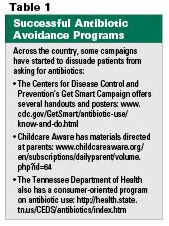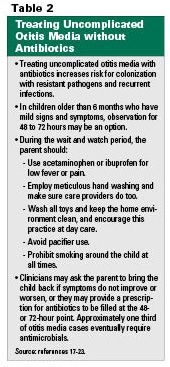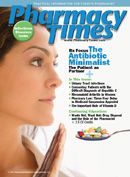Publication
Article
Pharmacy Times
The Antibiotic Minimalist: The Patient as Partner
Author(s):
Alternative treatments are available for fighting common viral infections-patients who are educated about these options can overcome the infection without antibiotics. Pharmacists can provide education and join local or national campaigns to help patients avoid antibiotic misuse.
Ms. Wick is a senior clinical research pharmacist at the National Cancer Institute, National Institutes of Health, Bethesda, Maryland. The views expressed are those of the author and not those of any government agency.

We all know. It is no secret. Science has confirmed it. Antibiotic resistance is a serious concern,1-4 and antibiotic overuse, especially for conditions involving upper respiratory symptoms and congestion, is a contributing factor.5-8 Adults who have developed colds, coughs, sore throats, or influenza often express a misinformed desire for antibiotics and pressure prescribers to provide them. A parent whose child develops otitis media may present at the pediatrician and demand antibiotics, despite the fact that experts advise against antibiotic use for most forms of otitis media.8 Providers, unable to deal with the pressure or too busy to use effective communication strategies, often just write a prescription, even though most of these conditions can be presumed to be viral.9,10 And the problem perpetuates itself. Educating prescribers is not enough. The most effective way to reduce demand is targeting another audience—patients.
The Well-Prescribed Antibiotic
At times, patients who present with upper respiratory infections (URIs), uncomplicated otitis media, or other symptoms may legitimately need antibiotics. Patients who have additional at-risk diagnoses—such as diabetes, asthma, chronic obstructive lung disease, or any autoimmune condition— may need prophylaxis. Prescribers may consider a course of antibiotics for patients who have histories of URI, pharyngitis, or otitis media in the previous 4 to 6 months. Patients who present with recurrent symptoms, despite antibiotic treatment in the last 30 days, are also candidates for another antibiotic course. Patients who present with strep symptoms after a close contact has tested positive for strep should also be treated.8,11
Community Campaigns
Increasingly, health care policymakers are urging communities to address the problem of patient perception that antibiotics are appropriate interventions for URIs and otitis media. These campaigns take many forms, but most use public service announcements about antibiotic misuse and overuse. They may use radio, television, newspaper, poster, or leaflet campaigns to help patients understand that many infections can be presumed to be viral, and interventions other than antibiotics are more effective. Pilot programs and studies have demonstrated that targeted campaigns can reduce antibiotic demand, resulting in up to 20% fewer prescriptions, compared with the preintervention period.11-14 The ability of these campaigns to change patients’ attitudes and decrease actual antibiotic use is excellent. Table 1 provides information about several successful campaigns.

Better than Antibiotics?
Prior to convincing patients that alternatives to antibiotics are available— and better—discuss basic prevention strategies. Although it may seem like you are closing the barn door when the horse is already in the pasture, patients can reinfect themselves with another viral or bacterial strain and infect others. It begins with promoting proper hand hygiene. Either soap and water or alcohol-based hand cleansers reduce infection due to viruses, although recontamination after hand washing occurs quickly. Hand hygiene compliance is low for many reasons; often, the main barrier is that frequent hand washing or use of alcohol-based sanitizers is drying to the skin. Nonalcoholic hand sanitizers are also available; some use low pH polymer to inactivate cold viruses and prevent their transfer to the respiratory system. Others use antimicrobial agents such as dimethyl benzyl ammonium chlorides.15,16
The “wait and watch” catchphrase is also helpful and engaging. Explaining that most URIs develop symptoms over 3 to 4 days and gradually resolve over 10 days to 2 weeks, with or without antibiotics, opens the door to discussion about red flags. These red flags include fever higher than 101.5ËšF; symptoms that escalate after 2 or 3 days; pungent yellow, green, or thick mucus; or systemic symptoms like muscle aches or gastrointestinal involvement. Should these occur, patients need to see their physician.
Another approach is to discuss cost, and most patients will understand that adding an unnecessary—and often costly—antibiotic wastes money.
Acute, uncomplicated otitis media is usually viral and self-limited and is accompanied by a viral URI. Convincing the parents of a feverish, screaming child who has an ear infection that an antibiotic is not necessary can be more difficult. Table 2 presents some compelling arguments and suggestions.

What Works?
Tailored counseling about what works can give patients the information they need to forego antibiotics. Basic interventions such as rest, ample hydration, and humidifier/vaporizer use increase comfort when a viral infection strikes. Many home remedies, OTC medicines, and herbal or alternative products provide far more relief than do antibiotics. For example, chicken soup is a favorite home remedy, and some studies prove it helps lessen the symptom burden of a common cold.24,25 OTC decongestants, antihistamines, antitussives, or analgesics can relieve some of the congestion, runny nose, cough, low fever, or aches that often accompany viral infections and reduce discomfort.
Among alternative products, vitamin C, honey, zinc, echinacea, garlic, ginger, and pelargonium sidoides are often taken for colds and flu symptoms. Counsel patients that the FDA does not demand the same level of efficacy and toxicity studies that it does for prescription or OTC drugs; but if patients find them useful, make sure they read the labeling and follow the directions.26-28
What Doesn’t Work?
When patients select a decongestant, counsel them to use the lowest effective dose just for as long as they need it. Prolonged or excessive decongestant use can dry mucous membranes and create a situation hospitable to bacteria. Topical decongestants work well but can cause rebound congestion if used more often than the labeling directs or for more than 3 days.29
The use of combination products can be effective, but it can also be troublesome. Choosing among the multitude of available products can be confusing, and pharmacists need to take a few minutes to explain product ingredients and their indications. Taking a medication when it is not needed creates unnecessary exposure to potential adverse events. When patients are taking analgesics for fever or aches, it is essential to screen OTC products for acetaminophen and warn patients about the analgesic’s maximum daily dose and generic and trade names.29
End Note
Educated patients can find the right treatment or combination of treatments and successfully navigate a viral infection without antibiotics. Each time a patient makes a conscious decision to avoid antibiotics and has a good outcome, the likelihood he or she will avoid antibiotics in the future increases. Pharmacists can help promote antibiotic avoidance by promoting, sponsoring, or joining local or national campaigns to educate patients. â–
References
1. Gonzales R, Steiner JF, Lum A, Barrett PH Jr. Decreasing antibiotic use in ambulatory practice: impact of a multidimensional intervention on the treatment of uncomplicated acute bronchitis in adults. JAMA. 1999;281(16):1512-1519.
2. Wenzel RP, Edmond MB. Managing antibiotic resistance. N Engl J Med. 2000;343(26):1961-1963.
3. Cohen ML. Epidemiology of drug resistance: implications for a post-antimicrobial era. Science. 1992;257(5073):1050-1055.
4. Whitney CG, Farley MM, Hadler J, et al. Increasing prevalence of multidrug-resistant Streptococcus pneumoniae in the United States. N Engl J Med. 2000;343(26):1917-1924.
5. Bell DM. Promoting appropriate antimicrobial drug use: perspective from the Centers for Disease Control and Prevention. Clin Infect Dis. 2001;33(suppl 3):S245-S250.
6. McCaig LF, Besser RE, Hughes JM. Trends in antimicrobial prescribing rates for children and adolescents. JAMA. 2002;287(23):3096-3102.
7. Otters HB, van der Wouden JC, Schellevis FG, van Suijlekom-Smit LW, Koes BW. Trends in prescribing antibiotics for children in Dutch general practice. J Antimicrob Chemother. 2004;53(2):361-366.
8. Spiro DM, Tay KY, Arnold DH, Dziura JD, Baker MD, Shapiro ED. Wait-and-see prescription for the treatment of acute otitis media: a randomized controlled trial. JAMA. 2006;296(10):1235-1241.
9. Gonzales R, Bartlett JG, Besser RE, et al. Principles of appropriate antibiotic use for treatment of acute respiratory tract infections in adults: background, specific aims and methods. Ann Intern Med. 2001;134(6):479-486.
10. Schwartz B, Bell DM, Hughes JM. Preventing the emergence of antimicrobial resistance. A call for action by clinicians, public health officials, and patients. JAMA. 1997;278(11):944-945.
11. Hemo B, Shamir-Shtein NH, Silverman BG, et al. Can a nationwide media campaign affect antibiotic use? Am J Manag Care. 2009;15(8):529-534.
12. Perz JF, Craig AS, Coffey CS, et al. Changes in antibiotic prescribing for children after a community-wide campaign. JAMA. 2002;287(23):3103-3109.
13. Belongia EA, Sullivan BJ, Chyou PH, Madagame E, Reed KD, Schwartz B. A community intervention trial to promote judicious antibiotic use and reduce penicillin-resistant Streptococcus pneumoniae carriage in children. Pediatrics. 2001;108(3):575-583.
14. Bauraind I, Lopez-Lazano JM, Beyaert A, et al. Association between antibiotic sales and public campaigns for their appropriate use. JAMA. 2004;292(20):2468-2470.
15. Eccles R. Mechanisms of symptoms of the common cold and influenza. Br J Hosp Med. 2007;68(2):578-582.
16. Guidelines for Hand-Hygiene in Healthcare Settings: Recommendation of the Healthcare Infection Control Practices Advisory Committee and the HICPAC/SHEA/APIC/IDSA Hand Hygiene Task Force. Centers for Disease Control and Prevention Web site. www.cdc.gov/mmwr/PDF/rr/rr5116.pdf. Accessed October 2009.
17. Larson EL, Lin SX, Gomez-Pichardo C, Della-Latta P. Effect of antibacterial home cleaning and handwashing products on infectious disease symptoms: A randomized, double-blind trial. Ann Intern Med. 2004;140(5):321-329.
18. Hanafin S, Griffiths P. Does pacifier use cause ear infections in young children? Br J Community Nurs. 2002;7(4):206-211.
19. Niemelä M, Uhari M, Möttönen M. A pacifier increases the risk of recurrent acute otitis media in children in day care centers. Pediatrics. 1995;96(5 Pt 1):884-888.
20. Owen MJ, Baldwin CD, Swank PR, Pannu AK, Johnson DL, Howie VM. Relation of infant feeding practices, cigarette smoke exposure, and group child care to the onset and duration of otitis media with effusion in the first two years of life. J Pediatr. 1993;123(5):702-711.
21. Ey JL, Holberg CJ, Aldous MB, Wright AL, Martinez FD, Taussig LM. Passive smoke exposure and otitis media in the first year of life. Group Health Medical Associates. Pediatrics. 1995;95(5):670-677.
22. Little P, Gould C, Williamson I, et al. Pragmatic randomised controlled trial of two prescribing strategies for childhood acute otitis media. BMJ. 2001;322(7282):336-342.
23. McCormick DP, Chonmaitree T, Pittman C, et al. Nonsevere acute otitis media: A clinical trial comparing outcomes of watchful waiting versus immediate antibiotic treatment. Pediatrics. 2005;115(6):1455-1465.
24. Hopkins AB. Chicken soup cure may not be a myth. Nurse Pract. 2003;28(6):16.
25. Jackson PM. Chicken soup. Wis Med J. 1994;93(1):3.
26. Shah SA, Sander S, White CM, Rinaldi M, Coleman CI. Evaluation of Echinacea for the prevention and treatment of the common cold: a meta-analysis. Lancet Infect Dis. 2007;7:473-80.
27. Pourahmad M, Sobhanian S. Effect of honey on the common cold. Arch Med Res. 2009;40:224-5.
28. Widdicombe JG, Ernst E. Clinical cough V: complementary and alternative medicine: therapy of cough. Handb Exp Pharmacol. 2009;187:321-42.
29. Handbook of Nonprescription Drugs, 16th ed. 2009 APhA Washington DC.







